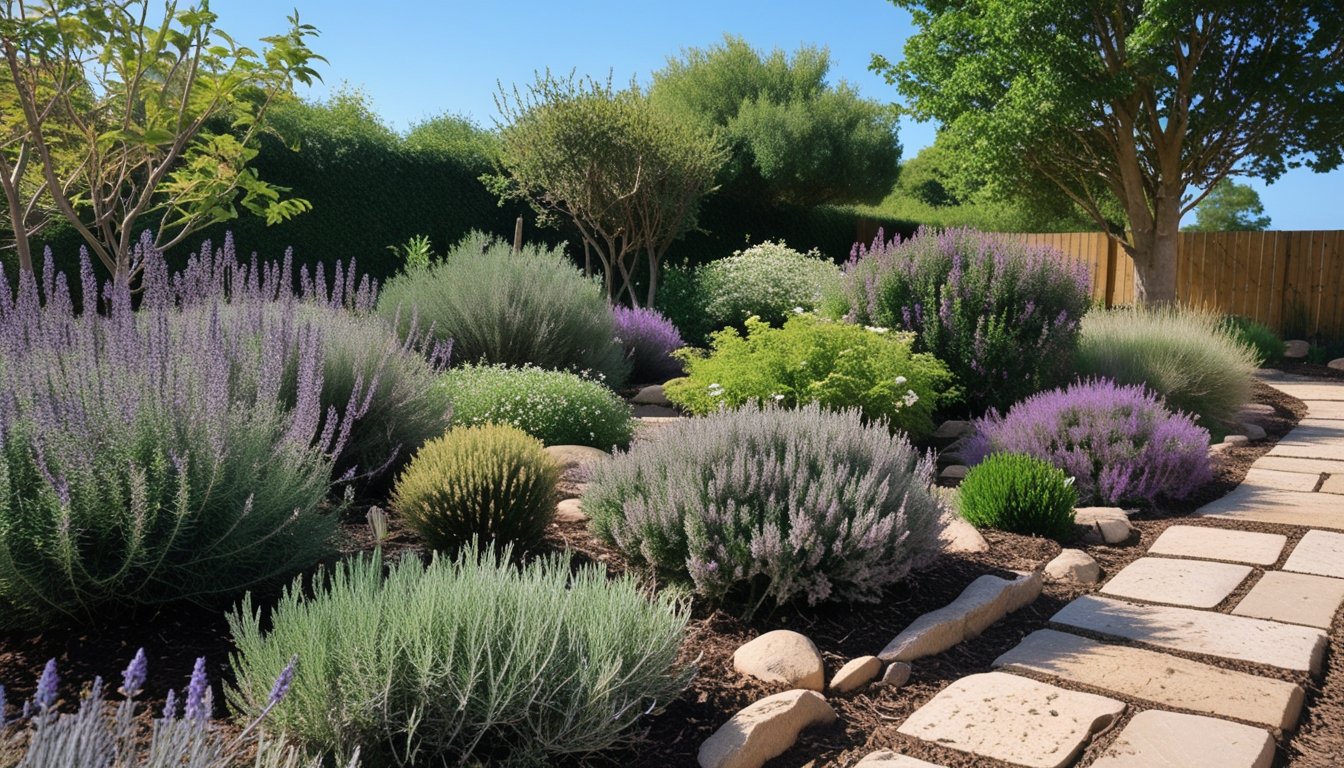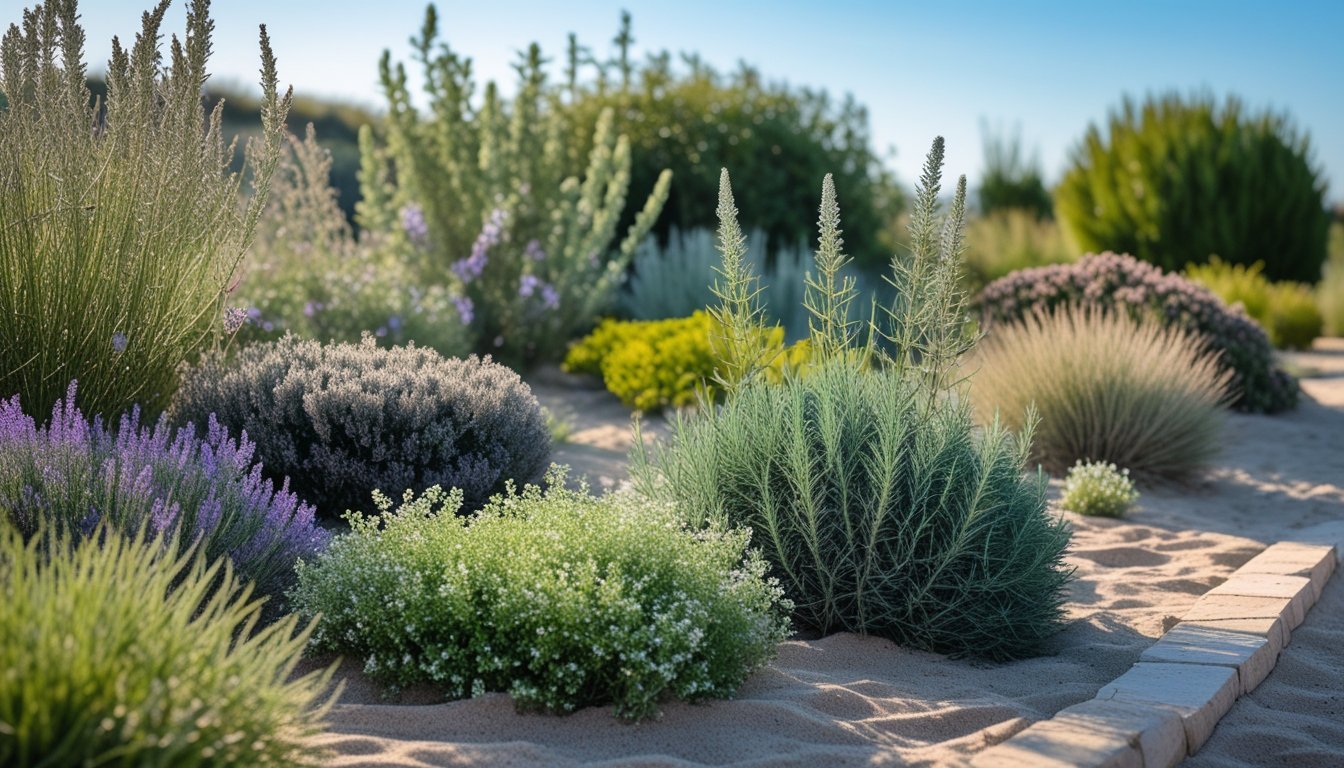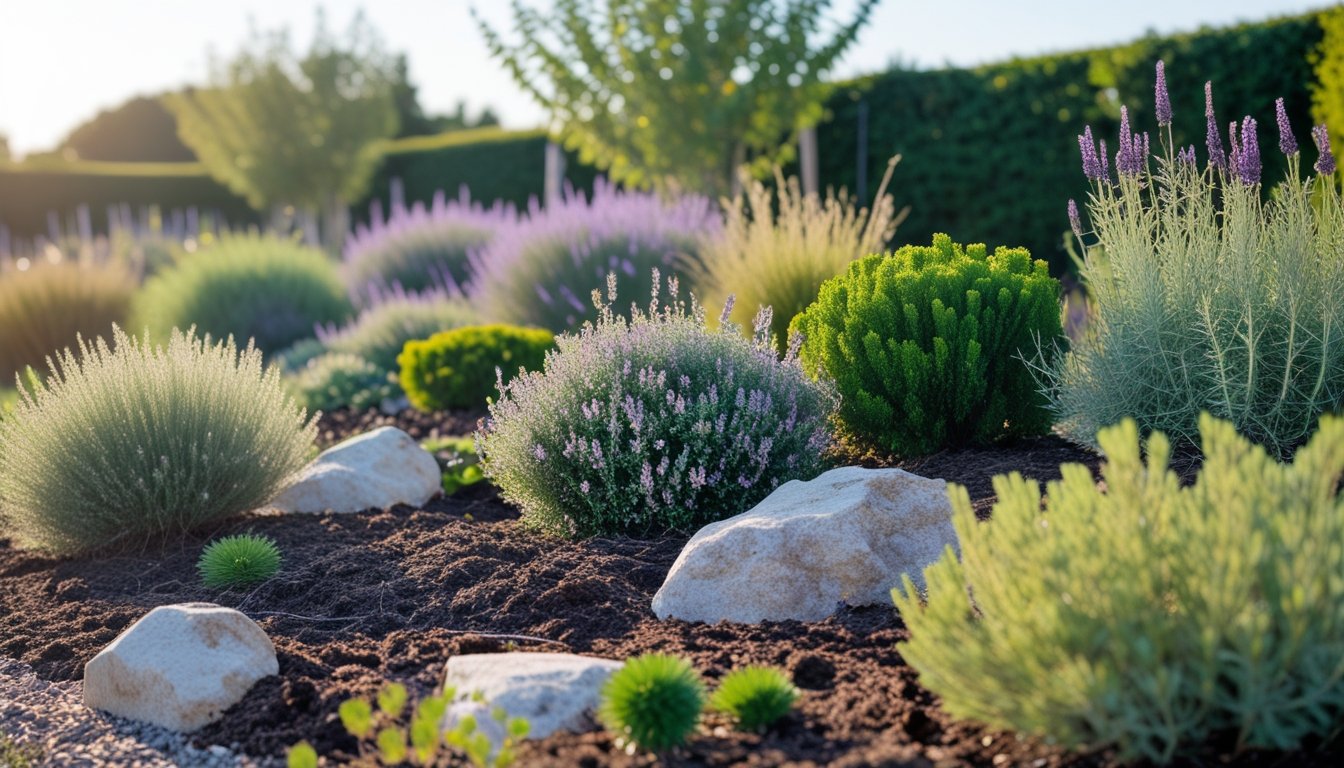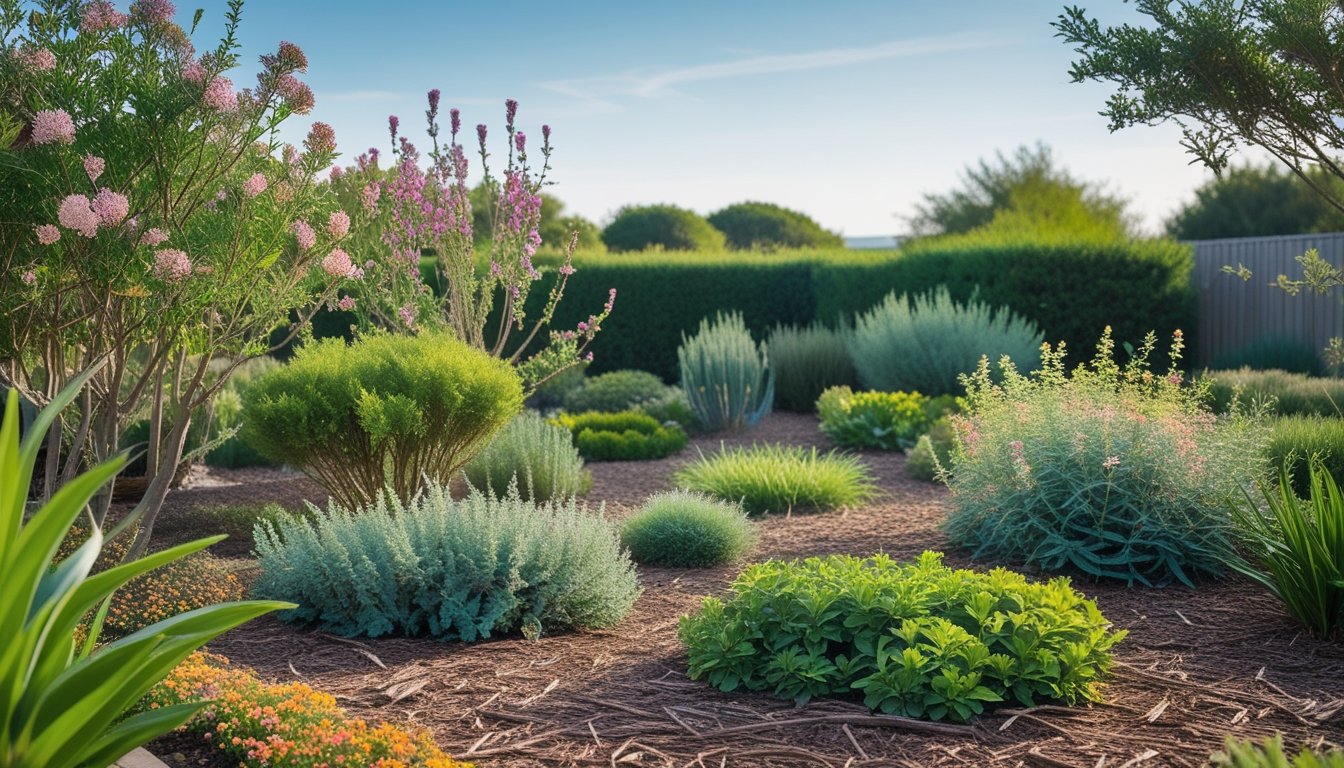Late updated: 14 Aug 2025 10:08
Written by: Emily Thornton
Designing A Drought-Resilient Garden With Native UK Shrubs: Expert Tips
Designing a drought-resilient garden in the UK involves a thoughtful selection of plants that can thrive with minimal water. Among these, native shrubs offer a remarkable solution, primarily due to their intrinsic adaptation to local climates. By incorporating these resilient shrubs into our landscapes, we ensure a vibrant garden throughout the year, even in increasingly dry conditions.

Native UK shrubs like hawthorn and elderberry not only withstand drought but also support local wildlife. As temperatures rise and precipitation patterns shift, these plants become essential for maintaining the ecological balance in our gardens. Our goal is to cultivate an outdoor space that flourishes naturally without excessive water consumption.
Adopting practical strategies such as mulching, soil improvement, and grouping plants with similar water needs enhances garden sustainability. These methods anchor the design principles of a drought-resilient garden. As gardeners, we embrace these techniques to transform our landscapes into thriving ecosystems that harmonise with the environment.
Key Takeaways
- Native UK shrubs are essential for drought resilience.
- Native plants support local wildlife and reduce water use.
- Practical strategies improve garden sustainability.
Core Principles of Designing a Drought-Resilient Garden with Native UK Shrubs

To create a drought-resilient garden in the UK, it's essential to select the right shrubs, provide support for native wildlife, and understand the regional climate's challenges. Native plants and drought-tolerant selections can transform our outdoor spaces into sustainable havens.
Understanding Drought and the UK Climate
The UK, typically known for its rain, has witnessed more frequent droughts due to climate change. These dry spells pose a challenge to traditional gardening practices. We must adapt by focusing on water-conserving methods. One key aspect is assessing annual precipitation patterns and understanding that periods of drought might become more common. The sun's intensity, prevailing winds, and regional soil types influence how drought impacts our gardens.
Embracing climate-smart practices such as reducing water use and capturing rainwater can significantly aid gardening efforts. Efficient irrigation, mulching, and organic matter also contribute to retaining soil moisture. By embracing these strategies, we create spaces that can thrive despite challenges.
Selecting Native and Drought-Tolerant Shrubs
Choosing the right shrubs requires understanding their adaptability and ecological benefits. Native flora, such as sea holly (Eryngium maritimum) and lavender (Lavandula spp.), are well-suited for UK climates and demonstrate exceptional drought tolerance. These plants not only conserve water but also flourish with minimal maintenance.
Sea holly offers architectural beauty with its spiky leaves and unique flower heads. Lavender is renowned for its fragrant blooms and ability to attract pollinators. Other versatile options include rosemary (Salvia rosmarinus) and hardy succulents that endure dry spells effortlessly. Incorporating a mix of perennials and evergreens ensures year-round interest and sustainability.
Supporting Pollinators and Native Wildlife
A thriving garden supports both flora and fauna, creating an ecosystem that benefits all. Pollinators, like bees and butterflies, are crucial for sustaining plant diversity and should be encouraged with nectar-rich plants. Shrubs like lavender and rosemary are excellent sources of nectar, enticing pollinators with their vibrant blooms.
Moreover, native shrubs and trees offer shelter and food for birds and other wildlife. By integrating diverse plantings, we foster habitats that support biodiversity. Hedgerows, for instance, can provide corridors for wildlife movement and contribute to a natural balance within our gardens.
With these practices, we nurture a resilient garden that prospers amidst the challenges posed by drought and climate change.
Practical Strategies and Techniques for Sustainable Drought-Resistant Gardening

Creating a drought-resilient garden involves thoughtfully preparing the soil, incorporating efficient water features, and implementing strategic irrigation methods. By adopting these practices, we can craft a garden that thrives with minimal water usage.
Soil Preparation and Organic Matter
Preparing the soil is fundamental to sustainable gardening. We can enhance water retention by integrating organic matter like well-rotted manure or mushroom compost. These materials increase soil structure and nutrient content. Sandy soil, common in many UK regions, benefits particularly from this enhancement.
Composting is another valuable technique, allowing us to recycle garden waste into a nutrient-rich soil amendment. This practice promotes soil health and sustainability. Incorporating adequate organic matter is key to supporting the root systems of drought-resistant shrubs native to the UK.
Water-Saving Design Features
To maximise our garden's water efficiency, strategic design features are essential. Incorporating rainwater harvesting systems is highly beneficial. These systems collect rainwater for use during dry spells, reducing our reliance on mains water.
By designing a landscape with natural water flow in mind, we can create areas where water naturally collects, supporting plant health. Slight depression areas or contours guide water where it's needed most, supporting a thriving ecosystem while minimising water waste. These small adjustments can significantly impact the garden's resilience.
Efficient Irrigation and Mulching Methods
Efficient irrigation systems, such as drip irrigation, provide direct water delivery to plant roots, reducing waste. With the assistance of timers, we can schedule watering during cooler periods, significantly improving water use efficiency.
Mulching techniques offer another layer of water conservation. A layer of organic mulch, such as straw or wood chips, helps retain moisture and insulates the soil. This approach reduces evaporation and helps suppress weeds. By combining mulching with precise irrigation, we ensure our garden remains lush with minimal water input.
Incorporating Gravel Gardens and Rock Gardens
Gravel gardens are an attractive and effective solution for drought conditions. By using gravel, we create a low-maintenance area with excellent drainage properties. Selecting drought-tolerant plants that thrive in well-drained environments is crucial.
Rock gardens further enhance our drought-resilient landscape. Using rocks and stones, we create visual interest and maintain moisture by providing shade and cooling the surrounding air. These gardens are ideal for planting UK-native shrubs with minimal water requirements, offering both beauty and functionality to our outdoor spaces.
Frequently Asked Questions

In our journey to design a drought-resilient garden, we explore how to select suitable plants and maintain landscapes that thrive in challenging conditions. Here, we address common queries on choosing the right shrubs and tips for water conservation.
What are the most suitable evergreen plants for a drought-tolerant garden in the UK?
To maintain year-round greenery, we recommend holly (Ilex), boxwood (Buxus), and juniper (Juniperus). These evergreens are well-suited to drier climates and will require less water while offering structure to your garden.
Which native shrubs thrive in dry soils, particularly beneath tree canopies?
Under tree canopies, conditions can be harsh. Gorse (Ulex europaeus) and broom (Cytisus scoparius) are resilient options. These native shrubs can survive with minimal water and provide texture and colour under shaded, dry conditions.
Which drought-resistant plants are recommended for container gardening in full sun?
For container gardening in sunny locations, lavender (Lavandula) and rosemary (Rosmarinus) are excellent choices. These aromatic herbs are both attractive and require minimal watering, making them perfect for pot planting.
Can you suggest a variety of drought-tolerant flowers that also attract pollinators?
To attract pollinators, consider goldenrod (Solidago), purple coneflower (Echinacea purpurea), and sedum (Sedum spectabile). These flowers support pollinator activity and bring life and vibrant colours to your garden while requiring little water.
How can one create a sustainable garden that copes well with dry shade conditions?
In shaded spots, consider using wood spurge (Euphorbia amygdaloides) and foxglove (Digitalis purpurea). These choices will help create a sustainable garden, with their natural ability to thrive under dry and low-light conditions.
What are the best practices for maintaining a garden's resilience during prolonged dry periods?
To ensure durability, mulching with organic materials retains moisture and suppresses weeds. Efficient watering techniques, such as drip irrigation, minimise water usage. Regular soil health checks help maintain its capacity to support plants during dry spells.
